Executive Summary
Two companies, viz. the Etisalat and the Du, serve the UAE’s telecommunication industry. Etisalat has enjoyed a monopoly market since 1976. Du was launched in 2007, and this move has caused a steep subscriber drop for Etisalat. This paper examines the marketing strategies employed by the two companies in the UAE.
The method used entails studying the information available in the magazines, promotional materials, website contents, and later interviewing customers randomly. The research has found that the two companies make strategies to beat each other. These strategies have been discussed in detail in this paper.
The research has also found out that the objective of Etisalat in the market is to offer quality services while that of Du is to offer affordable services. Consequently, Du has low-priced products, and Etisalat does not reduce its prices as a competing strategy. Despite Du having lower prices, Etisalat remains the largest market shareholder in the industry.
Introduction
Only two telecommunications companies operate in the United Arab Emirates (UAE). The companies are the Etisalat and the Du. Etisalat enjoyed a monopoly in the telecommunication industry until Du launched its operation in early 2007.
Nevertheless, Etisalat, which enjoys a market share of 80%, is the largest telecom in the UAE. Worldwide, Etisalat is the sixteenth largest telecommunications company. Mobile phone users in the UAE increased by a rate of 25.6 % every year, which beats the population growth of the country by four times (Business Monitor International, 2011).
The competition between the two rival telecoms, viz. Etisalat and Du are seen through their increasing market share convergence. For instance, Du has expanded its market share from 2.4% to over 40% within four years. According to its CEO, the company intends to increase its mobile market share to exceed 50% within two to three years.
The telecommunication sector in the UAE expects more segmentation in the future. The CEO further states that the domestic telecoms sector is expected to register the setup of new firms engaged in areas of digital services, digital content, and value-added services.
The two telecoms shape their products and services to attract a large number of expatriates in the UAE. All the two operators have products targeting the residents with families and friends living abroad. These products are in the form of promotions based on international calling rates and messaging (Business Monitor International, 2011).
The promotions may focus on religious festivals of certain groups or their traditional holidays. A good example is the Eid al-Adha festive season in November when the telecom operators reduce their rates (Kovacs, 2014). However, the two operators have permanent offers that allow subscribers to enjoy discounts on call rates to selected numbers. This feature includes both national and international options.
These services have emerged due to an earlier decision by the Telecommunication Authority (TRA) to ease previous regulations. It is now easier for the operators to change their rates so that they compete with one another more effectively. Surprisingly, this increasing competition has not caused prices to fall, unlike in other mobile markets. However, the case of the UAE could be due to the limited level of competition in the mobile market.
Since the two players are avoiding price wars, they concentrate on promotions and developing new services to attract customers. Therefore, it can be seen that the mobile market in the country is expanding. With the evolution of technology, novel products are emerging in the UAE markets.
Telecommunication services are very important, and much demanded in the UAE. Due to this demand, the two companies are moving fast to develop new products that attract more customers. In addition, they are developing marketing strategies that could push their products through this steep competition, and thus expand their market coverage. This paper explores the marketing strategies of Etisalat and Du telecom companies in the UAE.
Literature Review
Du versus Etisalat
The Emirates Telecom Company (Etisalat) started in the year 1976. It has been dominating the entire UAE telecommunications market as a monopoly until 2005 when this market dominance was broken as the TRA approved another company, viz. Du, in the industry. According to Business Monitor International (2011), the stakeholders of Etisalat entail the UAE government (60%) and the Emirati citizens (40%).
When Du entered the market, Etisalat officially changed its corporate logo. After changing the brand identities, Etisalat adopted a new approach due to the pressure from the new market entrant. The new approach adopted by the monopolist had a different vision and direction of creating public awareness. In addition, the entrance of the competitor saw the monopolist upgrade its customer care by adding a toll-free customer care line.
Du uses an outstanding strategy, which differentiates it from Etisalat. It offers “many choices to the customers and creates a difference in quality, innovation, and pricing of its products and services” (Hamid, 2013, par. 5). The rate at which the Du’s market share has increased from 2% to 40% within four years proves that it has been the customers’ preferred selection in the UAE market. The company’s strategy embraces cultural diversity, and thus its staff members are from more than 60 countries.
The company appreciates the “prosperous cultural diversity of the UAE and serves customers from a variety of languages and in a move to support the Emiratization movement in the UAE, more than 50% of its top management, and customer care staff are UAE nationals” (Hamid, 2013, pa. 7).
Du’s strategy focuses on offering a variety of high quality and cost-effective products and services. This element is the weakness of Etisalat, which has never revised its prices and strategies for a long time. These innovative and customer-centered strategies are enabling Du to attract more customers progressively.
Subscriber Dynamics
In 2011, Etisalat reported that its mobile subscriber base was 7.4 million users. However, the data from the TRA sources showed that the company had 6.463million subscribers at the end of 2011 (Kovacs, 2014). This aspect indicated that the company had suffered a reduction in subscribers for a second consecutive year.
Market data indicates that in 2010, up to 169,000 subscribers stopped using Etisalat, while in 2011, another 130,000 subscribers dropped the company’s services (Kovacs, 2014). The general slowdown experienced by Etisalat indicates a high mobile penetration rate in the UAE. In addition, it signifies intense competition from the competitor, viz. Du. This steep competition is having a considerable effect on the monopolist’s subscriber growth.
Due to this slow growth in recent years, the market share of Etisalat has continued to contract. According to the TRA figures, by the end of 2011, the monopolist’s market share had fallen to 58.4%, which was significantly down from 64.4% a year earlier (Business Monitor International, 2011). In 2010, the subscriber base of Du reached its record 4 million after hitting 4.333 million.
In 2011, Du experienced more growth through the addition of 271,000 subscribers, which translated into 6.3% growth. After this addition, its subscriber base stood at 4.604 million (Business Monitor International, 2011). This robust growth in subscriber base has resulted in the expansion of its market share from 9.3% in 2007 to 41.6% at the end of 2011.
In general, Du has been reporting higher subscriber additions as compared to Etisalat. It can be assumed that the new subscribers for Du have migrated from Etisalat, given that it is experiencing loss in the customer base. This market dynamic could change if the Virgin Group of UK launches its Mobile Virtual Network Operator (MVNO). In 2010, the group identified the UAE as a key market that it would target (Business Monitor International, 2011).
Subscriber Mix and ARPU
Like the majority of the markets in the Middle East, the UAE has a high number of prepaid subscribers. This aspect is attributed to the fact that Middle Eastern phone users change their mobile handsets frequently up to more than three times in a year. Consequently, the prospect of committing to a long-term agreement on a single handset becomes unattractive to the majority of the users.
The number of postpaid subscribers hit the one million mark at the end of 2010, which constituted about 9.8% of the total subscriber base (Business Monitor International, 2011). This aspect was a marginal increment from 9.3%, which was reported early the same year. During the same period, the prepaid subscribers fell from 90676 to 9.607. This fall could be attributed to the discounting of inactive lines.
In 2009, Du’s reports showed that it had about 170,000 postpaid subscribers on its network, which was about 4.9% of its total customer base (Kovacs, 2014). The operator had been in continued efforts to improve the quality of its subscribers. The efforts included offering attractive bundles containing free voice and data bundles.
Due to these efforts, the number of postpaid subscribers on its network increased to 194,000, which translates to 5% of its total subscriber base by the beginning of 2010. The growth in subscriber base continued in 2010 so that by the end of that year, the operator reported a net gain of 51,000, thus increasing its postpaid subscribers to 296,000, which was an equivalent of 6.8% of its total subscriber base at the end of 2010 (Business Monitor International, 2011).
A further expansion in subscriber base was experienced in early 2011, where 46,000 subscribers were recorded. After this addition, the operator’s postpaid subscriptions rose to 306,000. Nevertheless, there was no impact on the subscriber mix because increase intake of prepaid services meant that the proportion of postpaid subscriptions fell marginally to 6.6% of the total customer base by early 2011.
From the above subscriber data from Du and the market data from the TRA, it could be estimated that by early 2011, Etisalat had about 932,000 postpaid subscribers. It is important to note that Etisalat does not provide a breakdown of its subscriber mix. This aspect constitutes 14.4% of its total subscribers. From these figures, an increase is noted from 807,000 to 916,000 postpaid customers between March and December 2010.
Like its competitor, Etisalat sought to improve its subscriber mix and launched a new postpaid service dubbed MyPlan targeting existing and new postpaid customers. MyPlan offered four flexible packages with a maximum monthly tariff of AED449. In the package, there are different options for both international and local calls, mobile data, and text messages. The operator also provided subscribers with free smartphones or at discounted prices depending on the selected package.
The effect of this poor subscriber mix in the UAE is noticeable on the operators’ Average Return Per User (ARPU). In this case, Du is the only operator that releases regular ARPU data. The figures show a large fluctuation, which first rose to a peak of AED112 in December 2009. In early 2010, the ARPU fell to AED108, but rose again to AED111 by mid-2010.
This move was followed by another drop to AED108 and another rise to AED125 by the end of 2010. In early 2011, the ARPU dropped slightly to AED118 (Kovacs, 2014). This data is difficult to analyze because it does not follow a certain pattern, despite the steady customer base. It is likely that this trend is the same with Etisalat.
This fluctuation of ARPU experienced by Du could be explained by the impact of short-term promotional activities that the operator performs to attract new customers. For instance, during the festive season of Eid al-Adha, Du offered reduced tariffs for mobile and fixed-line international calls.
The operator further discounted rates for its voice calls and short messages (SMS). Etisalat also ran a similar promotion that allowed its subscribers to enjoy off-peak rates for international calls. In January 2011, Du launched another promotion, which offered free international and national calls as well as SMS and data bundles to its subscribers based on the package chosen.
Third Generation (3G) Services
Third generation (3G) mobile services have been available in the UAE since early 2004 under the Etisalat’s services, but the uptake was very low. However, in 2007, Etisalat had to take action owing to the impending end of its monopoly after Du launched its services. In order to increase its 3G subscribers, the operator took a step and canceled all the access fees for 3G services. Consequently, there was an increase in 3G take up, and the operator claimed to have up to one million 3G subscribers by mid-2007.
This move was followed by upgrading from W-CDMA to HSDPA (3.5G) technology. In 2007, Etisalat partnered with Nokia in a move aimed at accelerating the adoption of mobile Internet services on Nokia handsets (USA International Business Publications, 2007).
Through these moves, Etisalat managed to launch a 3.5G router in 2008, which could offer up to 7.2Mbps download speeds and support up to 32 real-time connections using a single SIM card. By June 2009, Etisalat completed its nationwide upgrade of the 3G network, which could enable download speeds of 14.4Mbps (Business Monitor International, 2011).
Within one month, Du announced its plans to expand its network coverage in high traffic areas. This move involved in-building upgrades, which improved indoor connectivity to shopping centers, airports, hospitals, universities, and hotels. These areas could have GSM, GPRS, EDGE, 3G, and 3.5G connectivity. The review of this literature shows a counter-strategy behavior between the two service providers. This paper will explore the particular strategies that the two rivals have implemented, the results they have achieved, and the reactions of each service provider to the competitor’s strategy.
Data Collection and Analysis
This section explains how the study of the marketing strategies of the two companies has been carried. The section reports a comparative analysis of the strategies adopted by the two service providers.
Method
The data used to compile this analysis was gathered from the promotional information materials from the companies’ websites, magazines, advertisements, newspapers, as well as other literature related to the subject. In addition, 110 subscribers were interviewed randomly and asked about their views about some marketing strategies of the two telecoms.
The Evaluation of Market Strategies
Etisalat
Market Segmentation
Etisalat has divided its market into different segments, viz. casual callers segment, business callers segment, and local callers segment. Two other segments, viz. expatriates late-night international caller segment and midnight international caller segment, have almost similar offers. Since the majority of the UAE population is expatriates, Etisalat has developed its favorite country plans to retain the share in the market.
The company encourages calling in late at night by offering off-peak hours so that the network is fully utilized. Its super off-peak hour is a midnight calling plan that encourages the users to make calls late at night. Expatriates from various regions across the world use this tariff extensively. Etisalat covers all segments of the market, and classes from the lower class, the middle class to the upper class, and business class.
Target Market Strategy
Etisalat targets the entire market and markets where users require quality services. It also seeks to cover the different segments with different attractive plans. Their strategy, in this case, is to ensure that the customers make calls cheaply during off-peak hours while enjoying quality services. These off-peak plans help to beat its network load. In addition, the strategy gives international economic calls during off-peak. The operator also alerts its customers in cases of occasional modified off-peak hours.
Pricing Strategy
The pricing of products is very important in every company as it helps to acquire market share in a very competitive market. Etisalat’s strategy on pricing is to offer a standard price to its customers, but at the same time, ensure good quality services. The company ensures that its network is always capable of handling voice traffic at any given time.
The connection fee of Etisalat remains higher than that of its competitor. In addition, Etisalat’s call rates have not changed significantly with time, but it gives several offers to the customers in the form of discounts. For new connections, Etisalat charges considerably high prices to connect the customer and make the product worth full.
Product Mix Pricing Strategies
Etisalat wins customers by its quality services, and it offers a bundle pricing strategy. These packages are made befittingly to suit the varying needs of different customers. The packages have reduced prices to meet the requirements of as many customers as possible. For subscribers who want to call late at night, the provider has a super peak hour in a package called Wasel.
The package offers low rates on international calls, but the callers have to incur higher prices for the local calls and SMS services. In a bid to recharge the Wasel prepaid package, Etisalat offers the following denominations 500AED, 200AED, 100AED, 50AED, and 25AED.
Price Adjustment Strategies
Etisalat operates a very complex tariff. For several years, there has been no significant reduction in local calls. However, the operator has multiple price strategies for its different plans. The company “designs suitable price plans using allowance and discount as well as promotion and segmented pricing strategies” (Cherrayil, 2014, par. 8). This way, it ensures that the plans suit the customers’ needs. Etisalat runs promotional and allowances pricing, and it offers discounted prices to increase uptake of its services.
Price Change Strategy
Due to the market situation, Etisalat cut its prices to maintain excess capacity. This move was driven by the fact that Etisalat seeks to maintain a fair price and save its brand image, although its prices remain higher as compared to those of the competitor. The price change strategy ensured that the price of the main products remained the same. This goal was achieved by reducing the connection and renewal fees and offering a payback option. With this strategy, the local call and the messaging charges remain the same.
Du Strategies
Market Segmentation
Du has divided its market into different segments, viz. casual callers segment, frequent callers segment, rare dialers segment, business callers segment, office break callers segment, visitors, and late-night international callers. For each plan, the operator has a suitable plan that meets the needs of the users.
The plans are very flexible, and the users can change to their favorite plan at the time of recharging. Quite interesting is the visitors’ plan for tourists and other visitors whose stay is limited to three months. This segment offers a connection validity of three months and has a balance back facility.
Target Market Strategy
The focus market for Du is where users are looking for low-cost calls. As compared to Etisalat, Du offers very attractive and lower-priced packages. These low-cost packages are the major factors that attract customers from Etisalat to Du.
Pricing Strategy
Du’s main objective is to increase its market share by offering very economical services to the appropriate market segment. Consequently, the operator offers very low prices as opposed to its competitor. Etisalat aims at offering quality services, and thus it does not respond to the low prices by dropping its prices, though it occasionally gives offers and discounts to its customers. The low price gives Du a competitive advantage, as customers are always cost-sensitive (Sinclair, 2013).
Product Mix Strategies
Just like its competitor, Du uses a bundle pricing strategy in its packages. This bundle pricing is advantageous to the company as on one side, it is an offer to the customers, and on the other side, there are conditions imposed. For instance, in its international package, subscribers get up to 30% extra credit valid for one month with the condition that all the credit has to be used to make international calls only.
Price Adjustment Strategy
Du has multiple price adjustment strategies. In all its packages, it adopts discount and allowance pricing. There is a bonus on credit, which is available on all packages, and it provides allowances to the users. This bonus credit is earned more as the subscribers continue using the service. Another price adjustment strategy used by Du is per second billing. This plan beats the Etisalat’s per-minute billing as the customers are satisfied that they are paying for only what they are using.
Price Changes Strategies
Du entered the market with the lowest prices and dropped them further to gain more market share. The operator has also revised its monthly package to the Elite package. This move is meant to provide a tariff, which is economical to the subscribers. Du also improved its bonus balance to attract customers to recharge more frequently.
The Analysis of Customer Views
Customers were asked to state which telecom company they trust in. The figure below shows their responses.
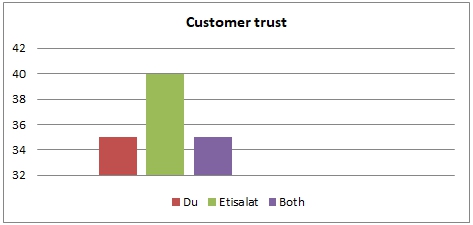
The number of subscribers for each service provider is represented below
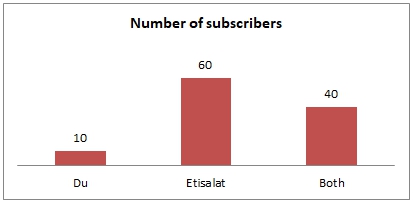
Customers were asked to state, which among the two service providers satisfied them. The responses are represented below.
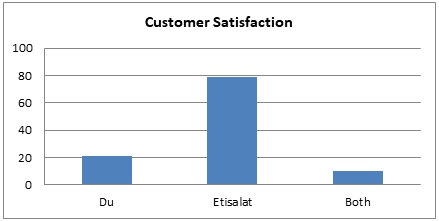
Customers were asked to rate the overall image of the companies. Figure 4 below shows their responses.
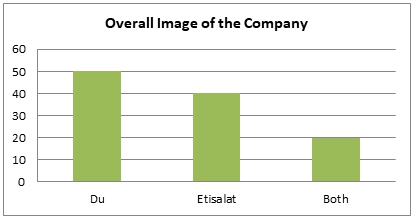
Customers were asked to state which company fully solved their communication problems. Figure 5 below represents their responses.
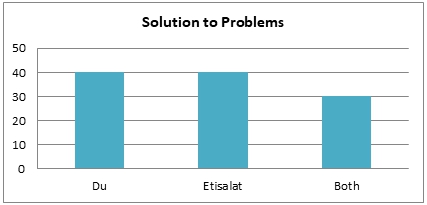
Customers were asked if they were aware of the new packages offered by their service provider. Figure 6 below shows their response.
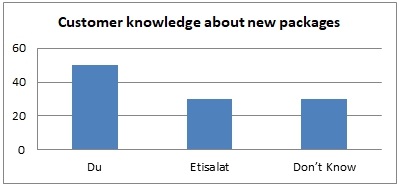
The survey carried by interviewing customers indicated that Etisalat still maintains the largest share by 54%, although 34% of the subscribers use both services. Out of the 110 subscribers interviewed, 40 of them trusted prices of Etisalat, while 35 of them trusted prices offered by the two companies.
There is a tie on whether the two telecoms solve the customers’ needs. This assertion is confirmed by an almost equal number that is satisfied by the services of the two operators. Du’s subscribers seem to be highly informed about the packages offered by their service providers. This aspect could be attributed to advertising and promotions.
Conclusion
Two companies serve the UAE’s telecommunication industry, viz. the Etisalat and the Du. Etisalat commands the largest market as it enjoys 80% of the market share. Since Du entered the UAE market, Etisalat has been experiencing a declining number of subscribers. This slowdown experienced by Etisalat indicates the high mobile penetration rate in the UAE. It also signifies intense competition caused by Du. This steep competition is having a considerable effect on the subscriber growth for Etisalat.
In a bid to attract more subscribers and retain the existing ones, the two companies have been employing counter-strategies. Etisalat has segmented its market into casual callers’ segment, local callers’ segment, business segment, expatriates late-night international caller segment, and the mid-night international caller segment.
The operator offers a different price package to meet the needs of its clients in each segment. On its side, Du has segmented its market into the casual segment, frequent users segment, rare users segment, business class segment, office break segment, visitors, and late-night international callers segment. Like its competitor, Du gives a suitable package for each segment.
The focus of Etisalat and its strategy on pricing is to offer a standard price to its customers, but at the same time, ensure good quality services. Therefore, the company ensures that its network is always capable of handling voice traffic at any given time. On the other hand, Du’s main objective is to increase its market share by offering very economical services to the appropriate market segment. Consequently, Du’s prices are lower as compared to those of Etisalat. Due to the differing market objectives, Etisalat does not respond by lowering its prices.
Recommendations
- Despite offering the lowest prices, customers still do not seem to trust Du. Therefore it needs to reverse this situation. Probably, customers doubt the services offered by Du, and thus the company should improve the quality and reliability of its services.
- Despite being the market leader, the image of Etisalat does not appear good to the customers. This aspect could be due to high prices as customers are cost-sensitive.
- The Etisalat’s subscribers seem not to be aware of what the operator is offering. The company needs to communicate thoroughly to its clients on what is on offer.
- Despite its low prices, customers do not seem to be satisfied with the services offered by Du, which could be due to the compromised quality of services.
Further Research
The Telecommunication Authority (TRA) has revised its regulations, thus making it easier for the operators to change their rates so that they can compete with one another more effectively. Surprisingly, this increasing competition has not seen prices falling, which is quite evident in other mobile markets. Therefore, there is in need to study this unusual market behavior in the UAE telecom market.
References
Business Monitor International. (2011). United Arab Emirates Telecommunications Report Q3 2011. London, UK: BMI.
Cherrayil, N. (2014). Etisalat offers better postpaid mobile value than du: report. Web.
Hamid, T. (2013). Competition is key in UAE telecoms sector. Web.
Kovacs, R. (2014). Economic and legal analysis of the United Arab Emirates’ telecommunications market. Web.
Sinclair, K. (2013). UAE telecom users outraged by du’opoly as bills hiked. Web.
USA International Business Publications. (2007). United Arab Emirates Telecommunication Industry Business Opportunities Handbook. Washington, D.C: Intl. Business Publications.